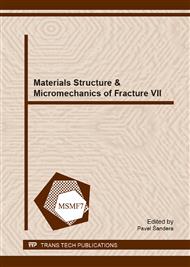p.3
p.14
p.22
p.30
p.39
p.43
p.47
p.51
Analysis of Fatigue Damage Accumulation in TiAl Intermetallics
Abstract:
In this work, a Ti-48Al-2Cr-2Nb alloy obtained with a additive manufacturing technique by electron beam melting (EBM) has been examined by conducting high cycle fatigue tests both with plain specimens and with specimens with artificially introduced defects with the objective of studying the growth behavior of small cracks. A consistent model for predicting the fatigue endurance strength of specimens with artificial defects is proposed, based on the Kitagawa diagram and taking into account of the presence of inherent microstructural features of the studied intermetallic alloy. Thus, the origin of fatigue failures due to intermetallic phases and orientation of lamellar colonies was investigated by means of micromechanical analysis through the use of high-resolution Digital Image Correlation (DIC). The local strain heterogeneities were measured out of the load frame by means of an optical microscope at high magnifications. The strain maps were then overlaid with the images of the microstructure and detailed analyses were performed to investigate the features of the microstructure where high local strain heterogeneities arise. High local residual plastic strains were measured inside lamellar colonies, which are detected as the precursor to fatigue crack initiation. The measure of the residual strains also provides further information on the role of the intermetallic phases on the fatigue behaviour of γ-TiAl alloys.
Info:
Periodical:
Pages:
30-35
Citation:
Online since:
November 2013
Authors:
Price:
Сopyright:
© 2014 Trans Tech Publications Ltd. All Rights Reserved
Share:
Citation:


